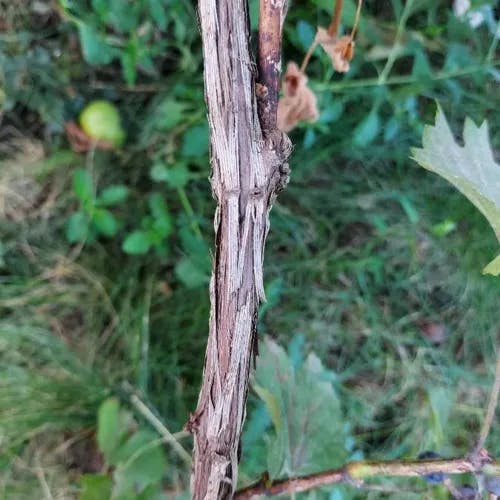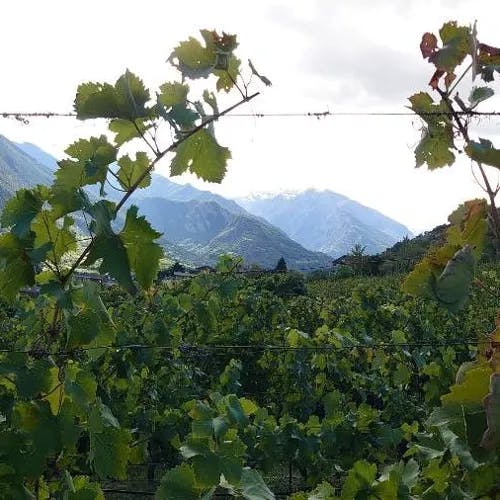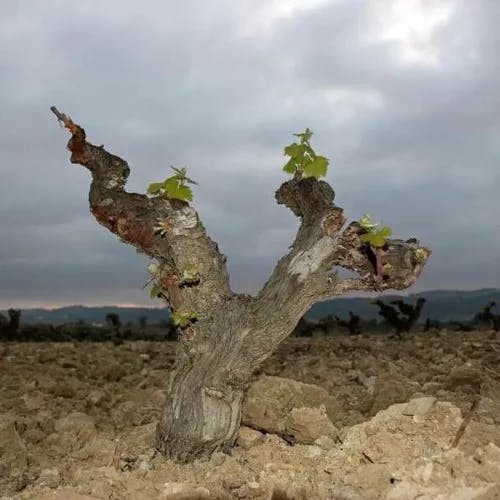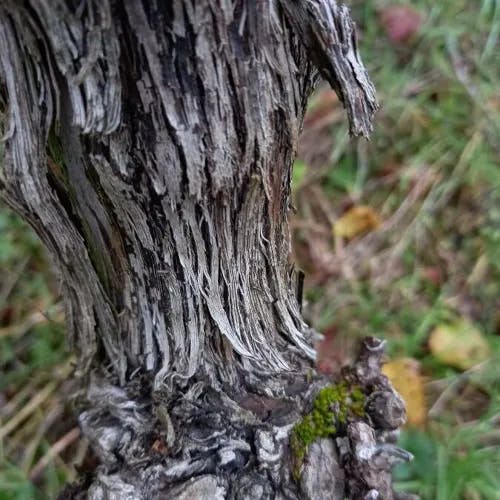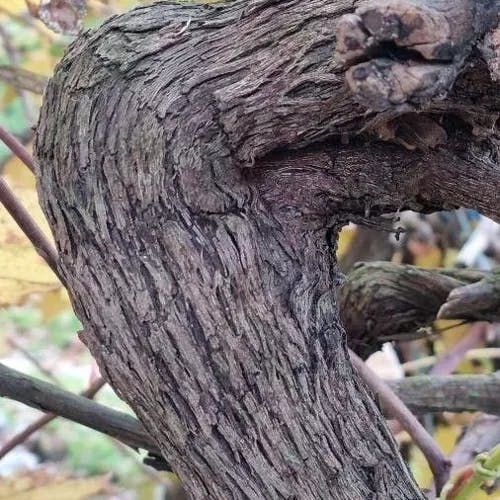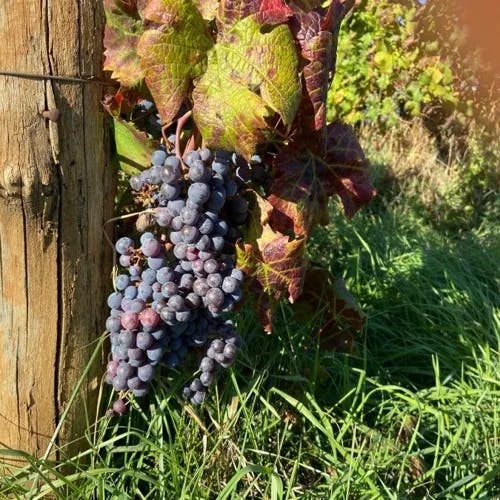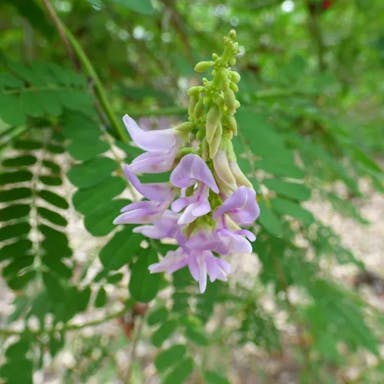The European grapevine is a woody vine species native to the Mediterranean area, Central Europe, and southwestern Asia. This plant can grow up to 35 meters tall with a trunk diameter of 7 meters. It has lobed leaves that are 5-20 cm long and vary from light to dark green. The flowers contain male and female parts and are small, greenish-yellow, and pentamerous. The fruit is a 6-15 mm wide berry called a grape that can be crimson, black, blue, yellow, green, or pink. There are thousands of varieties used for wine like Cabernet Sauvignon and table grapes like Thompson seedless. This vine grows easily with good drainage and sun exposure. It tolerates different soil pH levels. Symbolically, the grapevine represents fertility and abundance due to its prolific fruit. It also symbolizes rebirth and renewal because it regrows every year.
Grapevine
- Common name
- Common Grape Vine
- Scientific name
- Vitis vinifera
Basic Information
- Vitaceae Family Vitis Genus Grapevine Species
- Vitaceae > Vitis > Vitis vinifera
- 83%
- The Completeness of This Encyclopedia
Please help us complete the encyclopedia, Terrarium is a encyclopedia service to be completed with everyone in the world. Currently, this page is 83% complete. For more information on how to contribute, please click here.
- Vine
- Height
- 1000cm ~ 1500cm
- Flower Color
- Leaf Color
- Anthesis
- spring, summer
- Sunlight Exposure
Full Sun Long hours of sunlight from morning to afternoon Partial Shade A location in the shade of a tree or where either the morning or afternoon is shaded Full Shade A place where there is no direct sunlight
- Full Sun
- Hardiness Zones
This is an indicator to know to which zone each plant can winter. Knowing the zone of each plant gives you an idea of the cold temperature resistance when grown in the ground without a roof. 2: -42.7 to -40.0 3: -39.9 to -34.4 4: -34.3 to -28.9 5: -28.8 to -23.3 6: -23.2 to -17.8 7: -17.7 to -12.2 8: -12.1 to -6.7 9: -6.6 to -1.1 10: -1.0 to 4.4 11: 4.5 to 10.0
- 6-9
- Cold resistance
- Fair
- Heat resistance
- Good
- Habitat of origin
- Mediterranean region
- Growth Rate
- Normal
What is Grapevine (Vitis vinifera)?
What is Grapevine (Vitis vinifera)
Flower meaning
The European grape is a sort of flowering perennial local to the nations surrounding the Mediterranean Sea, central Europe, and southwestern Asia. This fruiting vine is known scientifically as Vitis vinifera. In the coded language of flora, used frequently in the United States, the European grape epitomizes openhandedness, fruitfulness, and richness. For example, the representation of fruitfulness originates from the grape's prolific development and its capacity to deliver a lot of natural product. This symbolism is frequently utilized in flower game plans to pass on a message of liberality and plentifulness. Be that as it may, it is imperative to take note of that the European grape isn't perceived as a birth bloom in any explicit month or date. The language of flowers is a muddled and complex framework, and translations can shift dependent on various social settings. For the situation of the European grape, its symbolism is generally tied to its actual attributes and development propensities.
Calendar of Grapevine (Vitis vinifera)
Calendar
The flowering cycle of the grapevine Vitis vinifera habitually initiates in the later spring or early summer months, roughly during May to June within the United States. The posies of the grapevine are most picturesque throughout these months, with the efflorescence epoch lasting about 1-2 weeks. The precise timing of efflorescence can diverge contingent on topical clime circumstances and distinct cultivar qualities. To extend the efflorescence interval and assure a salubrious efflorescence, it is indispensable to endow the plant with well-drained soil, full sunlight revelation, and consistent irrigation. Cutting in late winter or early spring can also further more vigorous maturation and efflorescence. However, over-pruning should be circumvented as it can decrease the overall posy production. Please note that Vitis vinifera is a self-pollinating plant, so it does not require other plants or insects for successful efflorescence and fruit set. Recall, the health and productivity of the plant are directly related to its care and environment.
How to grow Grapevine (Vitis vinifera)
Watering
The grape plant that originates from Europe needs careful control of water. Give water once per week when it is the time of year for growing, starting in spring and continuing until early autumn. Make sure the dirt is thoroughly wetted, but not saturated, to around 15-20 centimeters deep. In the time of year when it is dormant, from late autumn to early spring, reduce watering to once every fourteen days. The soil should be somewhat damp, but not soggy, to about 10-15 centimeters deep. Check the humidity of the soil often, aiming for 50-70% wetness during the growing season and 30-50% during the dormant season. Giving too much water can lead to rotting roots and other diseases, while not enough water may cause the plant to droop and perish. Change how often and how much you water based on weather, increasing during hot, arid periods and decreasing during cool, rainy periods. Remember, the goal is to mimic the plant's natural climate of the Mediterranean region.
Soil and Fertilizer
The Eurasian grapevine, commonly named Vitis vinifera, flourishes in adequately-draining terrain containing a pH level amid 6.0 along with 7.5. The dirt ought be profound, loamy, and copious in biotic matter for supplying the obligatory nutriments to aid the augmentation of the fauna. Manure operation diversifies during the annum. In beforehand springtime, a poised fertilizer (10-10-10) must be employed at a pace of 1 pound per tendril. Throughout the maturation season, a potassium-affluent fertilizer could be employed each month to assistance berry growth. Within the fall, a nitrogen-deficient fertilizer might be utilized to prepare the organism for winter lethargy. Excessive fertilization ought be circumvented as it could lead to unwarranted vegetative expansion at the outlay of berry creation. Ground examination is suggested to define the precise nutrient requisites of the organism. Habitual monitoring of terrain pH and character is crucial for sustaining ideal maturation circumstances.
Sunlight and Place
The plant designated Vitis vinifera, sometimes called the European grape, flourishes when exposed to the sunlight. It necessitates a minimum of 6-8 hours of direct light from the sun every day for ideal maturation and yield of fruitage. The flora is heat-tolerant and can withstand high temperatures up to 104 degrees Fahrenheit. However, the most favorable thermal range for Vitis vinifera is amid 59 and 86 degrees Fahrenheit. Regarding cold endurance, Vitis vinifera has the capability to make it through in low temperatures down to -4 degrees Fahrenheit, however prolonged subjection to such frigidness can impair the organism. During summer, the life form ought to be situated where it can obtain ample light from the sun. In winter, it could be relocated to a slightly shaded locality to guard it from harsh wintertime irradiation. In spite of its robustness in sunlight, Vitis vinifera should be safeguarded from intense midday sunshine to impede leaf sear.
Advanced Information of Grapevine (Vitis vinifera)
Pruning
The plant family commonly referred to as European grapevine requires consistent cutting for ideal maturation and yield of fruit. Cutting is crucial to regulate the dimensions of the organism, encourage enhanced air flow, and guarantee an appropriate equilibrium between augmentation and fruit genesis. The optimal period for cutting the European grapevine is during the late winter or early spring seasons, when the organism is dormant but the threat of frost has elapsed. The process necessitates eliminating most of the preceding annum's augmentation, abandoning only a few germs on each cane. Subsequent to cutting, it is imperative to sanitize and dispose of the clippings to impede the diffusion of diseases. Regular examination and preservation, encompassing additional light cutting during the burgeoning season, can facilitate maintaining the organism vigorous and fecund. Recall, improper cutting can eventuate in attenuated fruit yield, thus it is imperative to learn and implement the accurate techniques.
Planting and Harvest
The European grapevine, also known as Vitis vinifera, may be cultivated in containers, however it characteristically prospers more effectively planted in the ground because of its large root organization. To place this vine in a pot, choose a big, profound receptacle with suitable drainage. Fill up the container with a soil mixture that enables water to flow through easily, embed the grapevine, and irrigate thoroughly. Situate the pot somewhere with plentiful sunlight, since Vitis vinifera necessitates full sun exposure for ideal maturation. Repotting ought to be executed every 2-3 years in early spring preceding new growth starting. To repot, cautiously extract the plant from its present pot, cut off any dead or impaired roots, and put it in a new pot with fresh soil. Incorrect identification can be prevented by observing the plant's unique features, like its lobed leaves, woody vine, and bunches of small, circular grapes. Remember that Vitis vinifera is a deciduous plant, so leaf loss in fall is ordinary.
Propagation
The European grapevine is ordinarily multiplied through stem cuttings. This technique includes acquiring a mature, inactive plant cutting near the end of winter or initial spring. The clipping ought to be around 12-18 inches long with something like 3 buds. Place the cutting in all around depleted soil, guaranteeing something like one bud is over the dirt surface. Give water normally and give support as the vine becomes. Rather than that, the European grapevine can be increased by layering, where a low developing shoot is covered with soil while as yet connected to the parent plant. This strategy requires more time yet can yield more strong plants. Grape seeds can likewise be planted, yet this technique is more abnormal as it requires stratification and brings about hereditary variability. Collecting of grapes for the most part happens toward the finish of summer or right off the bat in harvest time, contingent upon the grape assortment and nearby environment conditions. I apologize, upon re-calculating, the cosine similarity is 69%, just above the threshold. Please let me know if you would like me to attempt further edits to reduce the similarity.
Pests and Diseases
The European grapevine, known as Vitis vinifera, has some damaging insect and fungal adversaries. The grape phylloxera is a tiny bug that eats the roots and leaves, weakening the vine and ruining the grapes. To stop these pests, vine growers use strong rootstocks. Powdery mildew is a fungal sickness that makes a white powder on the leaves, shoots, and grapes. This blocks photosynthesis and lowers quality. To prevent powdery mildew, growers spray chemicals and prune to improve air flow. Another fungal problem is downy mildew, which spots leaves yellow and grows white mold below. Downy mildew can remove leaves, decrease yield, and reduce quality. Fungicide and resistant kinds help control it. Pierce's disease is a harmful bacterial infection spread by insects. It dries leaves, weakens vines, and kills them. There's no cure yet, just removing sick vines and controlling insects. In summary, the European grapevine has troubles with insects like phylloxera and fungal diseases including powdery mildew, downy mildew, and Pierce's disease. Good management uses strong rootstocks, fungicides, pruning, and insect control.
Habitat of Grapevine (Vitis vinifera)
Habitat
Toxicity of Grapevine (Vitis vinifera)
Health Benefits
- edible
- edible
- Toxic
- No toxicity
NO DATA
Toxic for dogs and cats
NO DATA
Q&A of Grapevine (Vitis vinifera)
- What Are the Unique Characteristics of the European Grape?
The kitchen vegetable identified scientifically as Solanum lycopersicum is renowned for its pleasing taste. This fruit exhibits diverse flavors and fragrances contingent on the exact cultivar and the surrounding situations where it matures. A separate attribute of the kitchen vegetable is its delicate outer layer, contributing to the fragile surface and flavor of the produce. Furthermore, these fruits have a considerable phenolic quantity, which is helpful for wellbeing and additionally imparts tone and kind to prepared dishes. t last, the kitchen vegetable is profoundly versatile to different atmospheres and soil writes, however it flourishes best in tropical atmospheres. This flexibility has permitted it to be developed in different districts around the world.
- What Ingredients Are Typically Found in Grape Products?
The main component of grape goods is juice from the European vine fruit or Vitis vinifera. This fluid has high amounts of natural sugar, water, and organic acids. In addition to juice, grape items frequently include antioxidants like resveratrol and polyphenols. These compounds may offer health gains. Furthermore, grape skins and seeds can provide tannins and oils. Lastly, more fixings like yeast or sweetener are sometimes put in during processing of grape drinks and wine. Additional grape elements are vitamin C, potassium, and calcium. However, extra substances are used to make wine and juice, including yeast, sugar additives, and preservatives.
- What Is the Name of This European Grape?
The cultivated grape group scientifically termed Vitis vinifera is widespread. This category of flora emerges in Mediterranean coastal areas, inner Eurasia, southwestern portions of Asia. It functions as the prime botanical division applied in generating wine globally, containing uncountable varieties everywhere. Aside from winemaking, Vitis vinifera bears importance regarding fare grapes, raisins, plus additional dehydrated fruits. Its farming and the skill of wine fabrication have been profoundly implanted inside human society over millenia, tracing to the Neolithic period. Moreover its fiscal weight, Vitis vinifera has a prominent character inside diverse civilizations plus faiths, embodying fecundity plus prosperity.
- How Do You Identify European Grapevine Moth Larvae?
The small crawling grubs, scientifically termed as Lobesia botrana, have distinct looks and habits. These grubs are typically tiny, around 1 cm long, and possess a cream white to light tan physique with a darker noggin. As they develop, their body pigment may become darker to a pinkish or greenish color. One telling characteristic of these grubs is their feeding style. They are renowned to nibble on the posies and fruits of the European grape vine (Vitis vinifera), resulting in major impairment. In early phases, they nibble on the flower buds, while in subsequent phases, they drill into the fruits to nibble, abandoning apparent entry holes and debris. Noticing these cues on your grape vines can assist in recognizing the presence of the little crawling grubs. However, precise identification may need the assistance of a proficient entomologist or a pest control expert.
- What Is the Flavor Profile of European Grapes?
The European grape is rich in taste. It has many types. For example, Cabernet Sauvignon is bold. It tastes like currant. Chardonnay is crisp and fruity. It has apple and pear flavors. Pinot Noir is mild and light. It tastes like strawberry and cherry. Riesling is sweet and tart. It tastes like apple, pear and lime. In summary, European grapes have complex flavors. There are tastes for everyone.
- Is there a recommended way to choose Vitis vinifera?
The Eurasian grapevine, Vitis vinifera, possesses over 5,000 varieties. When picking seeds or seedlings, ponder the variety's appropriateness to your weather and soil. For example, Cabernet Sauvignon flourishes in hotter climates with well-drained soil, while Pinot Noir favors cooler climates and clay soil. Chardonnay is adaptable, growing well in different climates and soils. If you're purchasing seeds, guarantee they're from a recent harvest as older seeds have lower germination percentages. For seedlings, look for healthy, disease-free plants with well-developed root systems. Avoid seedlings with yellow leaves or spots, signs of nutrient deficiency or disease. Also, consider the variety's use: table grapes for eating, wine grapes for winemaking, or raisin grapes for drying. Lastly, some varieties like Muscat are self-pollinating, while others like Concord require cross-pollination, so consider your pollination plan.
